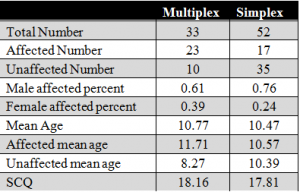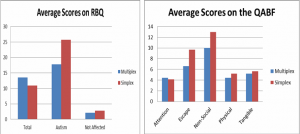David Ball and Dr. Blake Hansen, Counseling Psychology and Special Education
Introduction
The prevalence of autism has received considerable media attention in recent years. The Centers for Disease Control and Prevention recently assessed the prevalence of autism in children and determined that one in 68 children have autism.1
Our study analyzed functional behavior in families with one child with autism (simplex families) and in families with more than one child with autism (multiplex families). It also separated functional behavior assessments results by gender, since more children with autism are males, and by occurrence in families. These analyses had not been previously done. Our goal was to find these differences and to assess them.
Methodology
Families were recruited through social media announcements. Once demographic information was collected, the parents completed the Repetitive Behaviour Questionnaire2 (RBQ) for all of their living children. The RBQ is an 33-item parent-report questionnaire that has strong reliability and validity.2 There are two subscales on the RBQ; insistence on sameness/circumscribed interests (12 items, e.g. “making repetitive hand or body movements, carrying a teddy or blanket around with him/her, and saying the same things or make the same noises repeatedly”) and sensory/motor behaviors (15 items, e.g. “insisting items being put and stored in the same ways, playing the same music/game/video repeatedly, and talking about the same topic repeatedly”). Once the RBQ was completed, the parents completed the Questions About Behavioral Function3 (QABF) via telephone or video conference. QABF is a validated functional assessment checklist/rating scale that aims to identify the function of the repetitive behavior. Whether it was in pursuit of attention (engages in the behavior to get attention), escape (engages in the behavior to escape work or learning situations), non-social (engages in the behavior as a form of “self-stimulation”), physical (engages in the behavior because he/she is in pain), or accessing tangible items (engages in the behavior to get access to items such as preferred toys, food or beverages). QABF was completed with the most prominent behavior identified on the RBQ. Afterwards the parents filled out the Social Communication Questionnaire-Lifetime4 form (SCQ) to verify that their child(ren) were correctly diagnosed with autism.
Results
Participants included 85 children and adolescents, 52 of which were from simplex families (18 families) and the other 33 belonging to multiplex families (9 families). All affected children had community diagnoses from clinical psychologists and developmental-behavioral pediatricians, and received special education services at school. Participants from the simplex families ranged in age from 1.8 and 20.2 years (mean = 10.47 years) and the participants from multiplex families ranged in age from 0.8 to 20.5 years (mean = 10.77 years). Within the simplex group there were 28 males and 24 females of whom, 13 males and 4 females were diagnosed with autism. The multiplex group was comprised of 18 males and 15 females of whom, 14 males and 9 females were diagnosed with autism.

Simplex families showed a higher RBQ score than multiplex families (25.7 to 17.8) which was statistically significant.
Also there was a statistically significant differences in the QABF in both escape and non-social on functions of behavior. While attention, physical and tangible were non-significant.

Discussion & Conclusion
The results show that there are some significant differences between the simplex and multiplex families. To reduce repetitive behaviors, it may be beneficial to use different interventions in a simplex family than one would in a multiplex family. These results indicate a need for further research on both the topography and the function of repetitive behaviors in simplex and multiplex families.
Sources
- Baio, J. (2014, March 28). Prevalence of Autism Spectrum Disorder Among Children Aged 8 Years — Autism and Developmental Disabilities Monitoring Network, 11 Sites, United States, 2010. Retrieved August 31, 2014. <http://www.cdc.gov/mmwr/preview/mmwrhtml/ss6302a1.htm?s_cid=ss6302a1_w>
- Honey, E., McConachie, H., Turner, M., & Rodgers, J. (2012). Validation of the Repetitive Behavior Questionnaire for use with Children with Autism Spectrum Disorder. Research in Autism Spectrum
Disorders,6, 355-364. - Paclawskyj, T. R., Matson, J. L., Rush, K. S., Smalls, Y., & Vollmer, T. R. (2000). Questions about behavioral function (QABF):: A behavioral checklist for functional assessment of aberrant behavior. Research in Developmental Disabilities, 21(3), 223-229.
- Rutter, M., Bailey, A., & Lord, C. (2003). The social communication questionnaire: Manual. Western Psychological Services.
